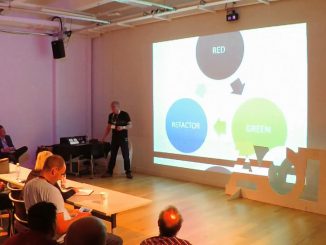Videos on Scrum and Agile Project Management
An important part of agile leadership is improving communication between people. M. Spayd and M. Hamman are talking about shifting from directive – “managing for results” leadership style to catalysing – “designing environments that create results” style. Lyssa Adkins recommends avoiding asking ”Why don’t you…?” questions when coaching, as being too offensive.
Scrum is becoming very popular and this iss good. Consciously or not, most people adopt Scrum by blindly following a so-called Scrum expert; that’s not so good. As more organisations look to an Agile transition to become more efficient, I am keen to make sure that they realise that there is more to Agile than just Scrum.
Individuals and interactions over processes and tools” how often have you heard this phrase from the Agile Manifesto? I strongly believe in it however we see that a good balance between the two parts is the key to succeed. As the Agile Manifesto says “That is, while there is value in the items on the right, we value the items on the left more”.
This talk explains the need for continuous improvement when adopting agile ways of working. It explores how continuous improvement is fundamental in agile, and what you can do to increase the agility of your teams and the organization as a whole.
Should agile practitioners avoid large corporate clients? Are they just too hard to take on a progressive agile journey? Helping companies that think they are already agile to actually adopt agile is an interesting challenge, for a start, nobody likes to be told that they are doing it wrong. In this video, David Espley shares his experience of helping larger corporate clients to act more like Lean startups, discusses how you wean people off their agile washed legacy processes and let go of some of the big company baggage.
Who says you need “stable” Scrum teams in order to build a successful software company? While the addition or removal of one person from a team means you have a “new team”, there is a myth out there about “stable” teams. When your Agile team compositions change it doesn’t mean you’re doing it wrong – it could be the secret to your success. Different companies have thrived through reteaming – the act of moving people around teams in different ways. This talk goes over the what, why and how of reteaming and shares stories from different companies who are living this reality.
Some software development teams are orders of magnitude more effective than others, turning around business solutions in days or even hours. Their secret is a combination of smart technology choices, great development habits and a powerful team dynamic. This talk describes a number of patterns of behavior that have been identified working with some great teams, beyond the basics of colocation, stand-ups and pair rotation. You’ll gain a new appreciation for old techniques like code reviews, and even working in silos won’t seem so bad!








